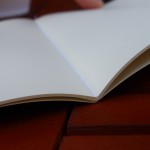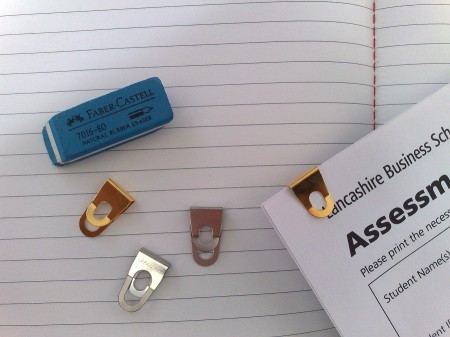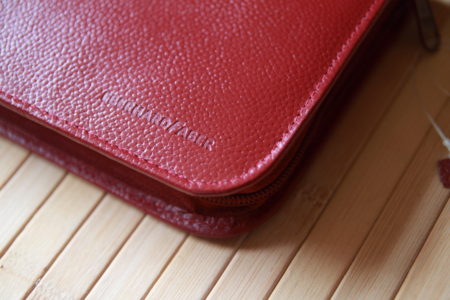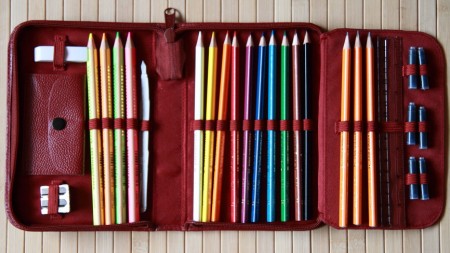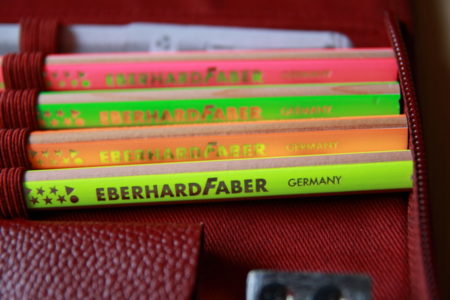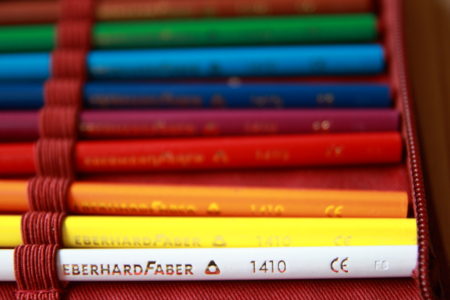Banditapple carnets
The first time I came across Banditapple carnets was when my friend Kent from Pencilog send me a few to try out. A few weeks later I received another envelope with Banditapple carnets, this time from Arnie Kim, the man behind the Banditapple carnets and an acquaintance of Kent. Kent told me that Arnie quit his job in Korea and went to Vietnam to create the perfect notebook. Vietnam was a French colony and was therefore influenced by French culture with the French-style carnet being no exception. Kent also added that Vietnam is the most suitable place in Asia to produce European-style notebooks. When I asked Arnie about his carnets he told me that he designed and planned the whole project and that he spent more than two years to find the right paper, the right “masters” to produce his carnets and the right location to make the carnets. The carnets currently available are the first edition, but he hopes to produce the second edition in a year or so.
Talking about the current edition he added that the paper is acid free paper and that it works great with a fountain pens, because the ink can dry quickly and because there is no feathering.
His Banditapple carnets are now being sold in the large stationery stores in Seoul and are also available in selected shops in Japan. He is also selling them online (contact banditapple@gmail.com if you are interested), with most orders being shipped to the USA and Japan, followed by Belgium, the Netherlands and Switzerland. The online sales are however tiny in comparison as Arnie does not have an online shop and these orders are based on word of mouth. The carnets are available in the following sizes:
- Peewee size, a moleskine pocket size, 9×14 cm
for 1,800 KRW (~$1.54, ~ €1.21, ~£1.00) - Handy Size, a midori traveler’s note size, 11×21 cm
for 2,800 KRW (~$2.40, ~€1.89, ~£1.56) - Tablet size, a moleskine large size, 13×21 cm
for 3,300 KRW (~$2.83, ~€2.22, ~£1.84)
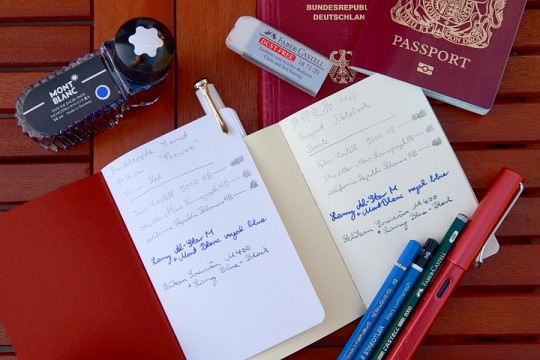
When I first looked at the Banditapple carnets my first impression was that they are very similar to Muji’s passport sized notebooks I bought in the past. If you have used Muji notepads before or read my previous posts about Muji (about their A5 notebook and their A6 memo pad) you know that Muji products look nice and are great for pencil users, but that their paper is not particularly fountain pen friendly. I use their white lined A6 notebooks to keep QSL logs, but I only use graphite pencils (mainly mechanical pencils) for this purpose. The similarities between the Muji passport notebooks and the Banditapple carnets lend themselves to comparing them. Keeping Kent’s and Arnie’s praise for their ability to cope with ink in mind (“The main partner with this notebook is actually fountain pen”) I decided to have a closer look and see how both cope with graphite and ink.

Both notebooks are sewn, not stapled, which adds a nice touch to them. While the Banditapple’s cover feels like normal, coloured paper the Muji’s cover seems to be made from impregnated paper, which will probably keep it looking new and tidy for longer. Another difference is that the Muji notebook was sewn with a white thread before the outer cover was glued on, so the seam is not visible from the outside, while the Banditapple was sewn with a red thread through the cover. The paper used in the notbook is also quite different. While the Banditapple’s paper looks a bit rough, Muji’s paper looks extremely smooth, nearly shiny in comparison and with a more yellowish tint.
Workmanship on both notebooks is very good, but if you are looking hard you can see that the last bit of thread is hanging loose on both notebooks and that the rounded corners of both notebooks could have been cut a bit better.
| Click on the images to see the texture in large. | |
Writing text using a pencil and erasing is fine in both notebooks, but shading the paper with a pencil does not really work well in the Muji notebook. Shading works much better in the Banditapple carnet, but the rougher paper means that the paper’s texture will be a little bit more obvious than in Muji’s notebook. The suitability for ink was tested with two different fountain pens and inks. I used a Lamy Al-Star with an M nib, filled with Montblanc royal blue ink and a Pelikan Souverän M400 white tortoise with a 14C F nib and Lamy blue-black ink [1]This is the blue-black ink from the bottle, not from the cartridge. I emphasise this because the blue-black ink from the bottle is said to be an iron-gall ink, while the blue-black cartridges are … Continue reading. This M400 is usually a very wet writer, but since this ink is very dry this combination overall is dryer than the Lamy / Montblanc combination. While the Banditapple carnet copes exceptionally well with both inks, the Muji notebook has some problems which result in the text being clearly visible on the back of the page.

The Banditapple carnet is the clear winner in this comparison, because of the superior paper. The Muji passport notebook paper does not perform well if you use ink or if you draw with pencils. I have to emphasise that the paper of the Muji passport notebook is performing much better than the paper in Muji’s A5 notebook I have reviewed previously. If you only write in notebooks and you only use pencils, then both will be excellent and the Muji will provide you with a cover that is more water and dirt-repelling.
I would like to thank Kent and Arnie for the Banditapple carnets used in for this post.
Arnie is an avid collector of postcards. If you would like to send him a postcard, please send it to:
Young-jo Arnold Kim
CPO Box 1754
Seoul
Republic of Korea
100-600
Prices and exchange rates: September 2010
References
| ↑1 | This is the blue-black ink from the bottle, not from the cartridge. I emphasise this because the blue-black ink from the bottle is said to be an iron-gall ink, while the blue-black cartridges are said to be just a mix of blue and black ink |
|---|
Banditapple carnets Read More »



